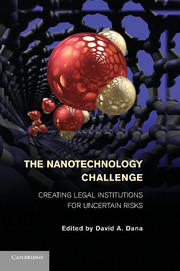Book contents
- Frontmatter
- Contents
- Contributors
- Part I Introduction
- Part II Public Perceptions of Nanotechnology Risks
- 3 Public Acceptance and the Regulation of Emerging Technologies
- 4 How Scientific Evidence Links Attitudes to Behaviors
- Part III Meeting the Nanotechnology Challenge by Creating New Legal Institutions
- Part IV Where We Are Now – The Current Framework for Nanotechnology Regulation
- Index
- References
4 - How Scientific Evidence Links Attitudes to Behaviors
Published online by Cambridge University Press: 05 December 2011
- Frontmatter
- Contents
- Contributors
- Part I Introduction
- Part II Public Perceptions of Nanotechnology Risks
- 3 Public Acceptance and the Regulation of Emerging Technologies
- 4 How Scientific Evidence Links Attitudes to Behaviors
- Part III Meeting the Nanotechnology Challenge by Creating New Legal Institutions
- Part IV Where We Are Now – The Current Framework for Nanotechnology Regulation
- Index
- References
Summary
Nanotechnology has the potential to revolutionize applications across a dizzying array of fields, including medicine, energy, cosmetics, computing, agriculture, and aerospace. Although many of these applications have become publically available, even more have yet to hit the marketplace. The ultimate plight of these technologies depends, in large part, on public acceptance and usage. New technologies will not find commercial acceptance or overcome regulatory hurdles if they are not embraced or at least tolerated by customers.
A growing body of work explores the determinants of attitudes or opinions about nanotechnology (e.g., Cobb & Macoubrie, 2004; Lee et al., 2005; Scheufele & Lewenstein, 2005; Lee & Scheufele, 2006). Yet the bulk of this work overlooks two important dynamics. First, public opinion analysts often strictly distinguish the role of factual information (e.g., knowing a nanometer is a billionth of a meter) from the impact of alternative processes such as framing (e.g., being told that nanotechnology has implications for energy costs). This is unfortunate because much of the information citizens receive melds frames and facts, as when an energy frame provides facts about cost savings. How does adding factual content to a frame influence public reactions? Second, extant work rarely explores the relationship between nanotechnology opinions and willingness to actually use nanotechnology – despite the well-documented disconnect between attitudes and behaviors, more generally. When do nanotechnology attitudes (e.g., support for investment and usage) predict behaviors (e.g., willingness to personally use)?
- Type
- Chapter
- Information
- The Nanotechnology ChallengeCreating Legal Institutions for Uncertain Risks, pp. 84 - 102Publisher: Cambridge University PressPrint publication year: 2011
References
- 2
- Cited by

